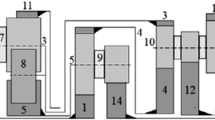Abstract
This paper presents an analytical geometry method for kinematics and efficiency of planetary gear trains (PGTs). The novel method which is capable of evolution and contrast analysis of mechanism kinematics, can be applied to any typical one- and two-degree-of-freedom plane PGTs containing any number of simple, compound or complex-compound planetary gear sets. The efficiency analysis of this method features a systematized and programmed process and its independence of the speed ratio. The primary contribution of this work lies in the integration of quantitative calculation, qualitative evolution and comparative analysis of kinematics of PGTs into one diagram, and in the integration of kinematics and efficiency analysis into a single method system. First, the analytical geometry method is defined, its basic properties are given, and the systematization procedure to perform kinematic analysis is demonstrated. As an application, analytical geometry diagrams of common PGTs are exhibited in the form of a list, whose kinematic characteristics and general evolution tendency are discussed. Then, with the mapping of PGTs onto the angular speed plane, the efficiency formula of analytical geometry, which has an extremely concise form, and a simple method for power flow estimation are put forward. Moreover, a general procedure is provided to analyze the efficiency and power flow. Finally, four numerical examples including a complicated eleven-link differential PGTs are given to illustrate the simpleness and intuitiveness of the analytical geometry method.
Similar content being viewed by others
References
Tsai L W. An application of the linkage characteristic polynomial to the topological synthesis of epicyclic gear trains. J Mech Transm Autom Des, 1987, 109(3): 329–336
Rao Z G. Design of Planetary Gear Transmission (in Chinese). Beijing: Chemical Industry Press, 2003
Design and Manufacture of involute planetary gear transmission (in Chinese). Beijing: China Machine Press, 2004
Freudenstein F. An application of boolean algebra to the motion of epicyclic drives. ASME J Eng Ind, 1971, 93(Series B): 176–182
Tsai L W. The kinematics of spatial robotic bevel-gear trains. IEEE J Robot Autom, 1988, 4(2): 150–156
Hsieh L C, Yan H S, Wu L I. Algorithm for the automatic kinematic analysis of planetary gear trains by fundamental circuit method. J Chin Soc Mech Eng, T Chin Inst Eng-Ser C, 1989, 10(2): 153–158
Hsu C H, Lam K T. A new graph representation for the automatic kinematic analysis of planetary spur-gear trains. J Mech Des, 1992, 114(1): 196–200
Hsieh H I, Tsai L W. Kinematic analysis of epicyclic-type transmission mechanisms using the concept of fundamental geared entities. J Mech Des, 1996, 118(2): 294–299
Chatterjee G, Tsai L W. Computer-aided sketching of epicyclic-type automatic transmission gear trains. J Mech Des, 1996, 118(3): 405–411
Liu C P, Chen D Z. On the application of kinematic units to the topological analysis of geared mechanisms. J Mech Des, 2001, 123(2): 240–246
Liu C P, Chen D Z, Chang Y T. Kinematic analysis of geared mechanisms using the concept of kinematic fractionation. Mech Mach Theory, 2004, 39(11): 1207–1221
Chen D Z, Shieh W B, Yeh Y C. Kinematic characteristics and classification of geared mechanisms using the concept of kinematic fractionation. J Mech Des, 2008, 130(8): 082602
Ma R, Gupta K C. Signal flow graphs for spatial gear trains. J Mech Des, 1994, 116(1): 326–331
Rao A C. A genetic algorithm for epicyclic gear trains. Mech Mach Theory, 2003, 38(2): 135–147
Kahraman A, Ligata H, Kienzle K, et al. A kinematics and power flow analysis methodology for automatic transmission planetary gear trains. J Mech Des, 2004, 126(6): 1071–1081
Talpasanu I, Yih T C, Simionescu P A. Application of matroid method in kinematic analysis of parallel axes epicyclic gear trains. J Mech Des, 2006, 128(6): 1307–1314
Pennock G R, Alwerdt J J. Duality between the kinematics of gear trains and the statics of beam systems. Mech Mach Theory, 2007, 42(11): 1527–1546
Tsai M C, Huang C C, Lin B J. Kinematic analysis of planetary gear systems using block diagrams. J Mech Des, 2010, 132(6): 065001
Müller H W. Epicyclic Drive Trains: Analysis, Synthesis and Applications. Detroit: Wayne State University Press, 1982
Hedman A. Transmission analysis-Automatic derivation of relationships. J Mech Des, 1993, 115(4): 1031–1037
Tian L, Lu L Q. Matrix system for the analysis of planetary transmissions. J Mech Des, 1997, 119(3): 333–337
del Castillo J M. Symbolic computation of planetary gear train efficiency. In: European Congress on Computational Methods in Applied Sciences and Engineering CIMNE, Barcelona, 2000
del Castillo J M. The analytical expression of the efficiency of planetary gear trains. Mech Mach Theory, 2002, 37(2): 197–214
Salgado D R, del Castillo J M. Selection and design of planetary gear trains based on power flow maps. J Mech Des, 2005, 127(1): 120–134
Lin J D, Chen X A. Simplified approach for the determination of the mechanical efficiency in gear trains (in Chinese). Chin J Mech Eng, 2004, 40(9): 33–37
Chen C, Angeles J. Virtual-power flow and mechanical gear-mesh power losses of epicyclic gear trains. J Mech Des, 2007, 129: 107–113
Mantriota G, Pennestrì E. Theoretical and experimental efficiency analysis of multi-degrees-of-freedom epicyclic gear trains. Multibody Syst Dyn, 2003, 9(4): 389–408
Esmail E L, Hassan S S. An approach to power-flow and static force analysis in multi-input multi-output epicyclic-type transmission trains. J Mech Des, 2010, 132(1): 011009
Pennestrì E, Valentini P P. A review of formulas for the mechanical efficiency analysis of two degrees-of-freedom epicyclic gear trains. J Mech Des, 2003, 125(3): 602–608
Willis J R. On the kinematics of the closed epicyclic differential gears. J Mech Des, 1982, 104: 712–723
Wolfram S. The Mathematica Book. 5th ed. New York: Wolfram Media, 2003
Author information
Authors and Affiliations
Corresponding author
Rights and permissions
About this article
Cite this article
Chen, X., Chen, H. Analytical geometry method of planetary gear trains. Sci. China Technol. Sci. 55, 1007–1021 (2012). https://doi.org/10.1007/s11431-011-4736-y
Received:
Accepted:
Published:
Issue Date:
DOI: https://doi.org/10.1007/s11431-011-4736-y




